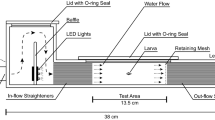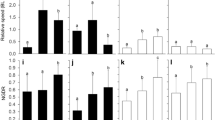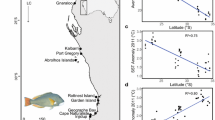Abstract
Characteristics of the pelagic stages of reef fishes have generally been investigated at the family level, which may mask important differences among species. Here the variation in sustained swimming ability of the late pelagic stages is examined among species, within two families (Pomacentridae and Chaetodontidae). The pomacentrids displayed a 7.5-fold difference in sustained swimming ability across 24 species, while the chaetodontids displayed a 2-fold difference across 10 species. The variation within the Pomacentridae was not related to pelagic larval duration, post-settlement habitat or taxonomy. There was, however, a significant correlation between sustained swimming ability and total length (TL) of individuals (r=0.435, P<0.0001). Differences in the mean distance swum by pomacentrid species, however, was most strongly related to differences in mean wet weight (r=0.814, P<0.0001). When the mean distance swum by species was scaled with respect to mean TL there was still a strong correlation with mean wet weight (r=0.644, P<0.005). Among chaetodontid individuals TL and sustained swimming ability were not correlated (r=−0.004, P=0.978). Furthermore, sustained swimming ability was not significantly related to the trans-oceanic distribution of species in either family. The variation in sustained swimming ability, however, may contribute to explanations of the observed levels of gene flow within populations.
Similar content being viewed by others
Author information
Authors and Affiliations
Additional information
Accepted: 24 November 1997
Rights and permissions
About this article
Cite this article
Stobutzki, I. Interspecific variation in sustained swimming ability of late pelagic stage reef fish from two families (Pomacentridae and Chaetodontidae). Coral Reefs 17, 111–119 (1998). https://doi.org/10.1007/s003380050104
Issue Date:
DOI: https://doi.org/10.1007/s003380050104





